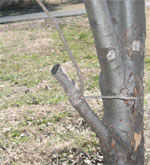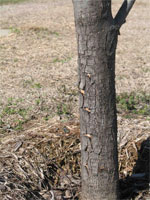Question and Answer – March 2010
Neil chooses questions that will be of the most general reader interest. However, he requires a photo, so that others can see the plant or problem in question. He requests that you identify your home city, as his answer could vary from one area to another. No plant IDs, please, since they’re of interest only to the person sending them.
Question: I’m wondering if I have a problem with my pecan tree. It was planted from bare-root stock in 2005. We budded it in three places a couple of years later, but only one bud took. We are leaving it as a native pecan for the time being, until we can see how the one bud does. The rest of the tree is growing really well. I am concerned about the tree’s bark and some small holes I see. I believe they’re due to woodpeckers, and therefore of little concern, but I wanted to be sure. The holes only extend into the wood about 1/4 inch. T.A., Granbury.
Answer: It would really help to see this tree leafed out during the growing season, to be able to compare the relative vigor of the budded shoot and the regular native branches. Those native shoots seem to be getting the lion’s share of the water and nutrition, and your bud probably will gradually fade away unless you remove the top growth and force the bud to grow more vigorously. However, the bud shoot is off-vertical, and you may find that branch angle to be unattractive. As for the holes, since they’re so shallow, you’re probably correct on assuming sapsuckers to be the cause. However, there is a random appearance to a few of the holes, rather than the straight rows we traditionally see with the birds. Open a paper clip and insert it into several of them. If they are only 1/4-inch deep, they wouldn’t be due to borers, and that would be good. Sapsuckers are of no concern. Borers suggest much more major problems.
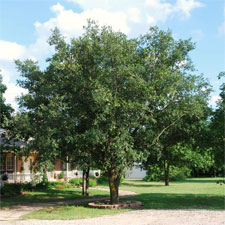
Question: We plan to add additional trees to our landscape this spring, and we are quite fond of live oaks. Are there varieties that will produce a spreading, or at least a round crown? How far apart should they be planted if our goal is to have them grow to touch one another? Are there male and female live oaks, so we could avoid acorns? Can you recommend a nursery where we could find a live oak that would grow somewhat like the one in the attached photo? J. and B. Y., McKinney.
Answer: Visit several nurseries to find the best live oak for your needs. You’ll notice that smaller leaves tend to go with trees that arch, even weep. They bring a graceful elegance to their surroundings. Live oaks with larger leaves often are more rounded, similar to the one in your photo. By looking at scores of live oaks in nurseries, you’ll quickly see how much they can vary. You’ll be able to plug in your own criteria and make your decision yourself. Almost any full-service, independent retail garden center will have nice specimens of live oaks. By choosing a tree that is several inches in diameter, you’ll be able to see its mature growth form developing. Space live oaks 40 feet apart at a minimum. Their mature spread approaches 60 to 75 feet for very old trees. As for the acorn issue, all oaks will produce them. The quantities will vary greatly from one year to the next, just as they do with pecans.
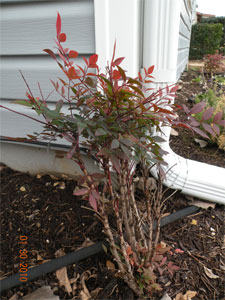
Question: I have two dwarf nandinas that have lost all of their bottom leaves. It started in late summer. They’re in different beds, but they look about the same. What can I do with them? K.M., West.
Answer: Cut the bare stems back to within 2-3 inches of the ground immediately, and apply an all-nitrogen fertilizer around them, 1/4 cup per plant. Scratch the plant food into the top inch of soil, and water thoroughly. You should see several new shoots emerge from the soil within just a few weeks. Your plants may have gotten too dry last summer. Their natural tendency, when confronted with bad growing conditions, is to drop many of their lower leaves. The severe trimming will restore their good looks. In fact, you’ll probably want to do a lesser version of this stem removal every winter, mainly to keep the plants compact and full to their bases.
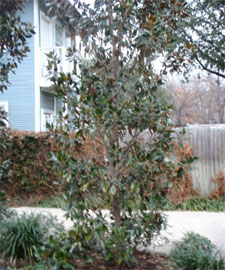
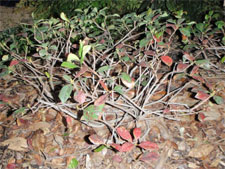
Question: Can you help, please, with my Indian hawthorns and Little Gem magnolias? Both are sparse. How can I thicken them up? C.H., Dallas area.
Answer: The thinning has been caused by two different things. The magnolia may just have gotten a little bit dry at some point. Apply an all-nitrogen fertilizer around its drip line, then water it in thoroughly. It just needs a little time. The Indian hawthorns, on the other hand, have very little time left. They’ve been infested with the oft-fatal disease known as Entomosporium fungal leaf spot. It’s the same organism that has virtually ruined our redtip photinia plantings nationwide. There is no chemical control for it, and for that reason, best guess is that these plants will continue to decline.


